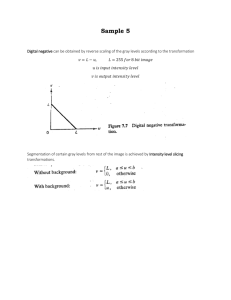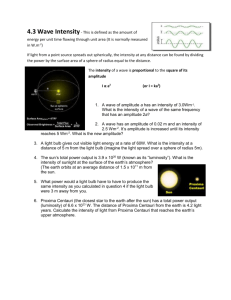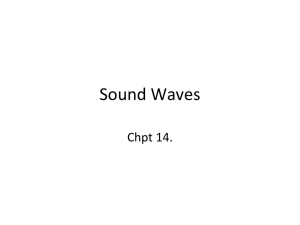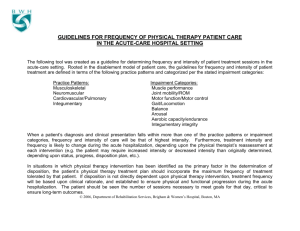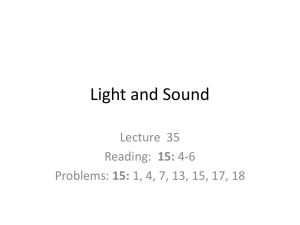Most prominent airglow night at El Leoncito
advertisement
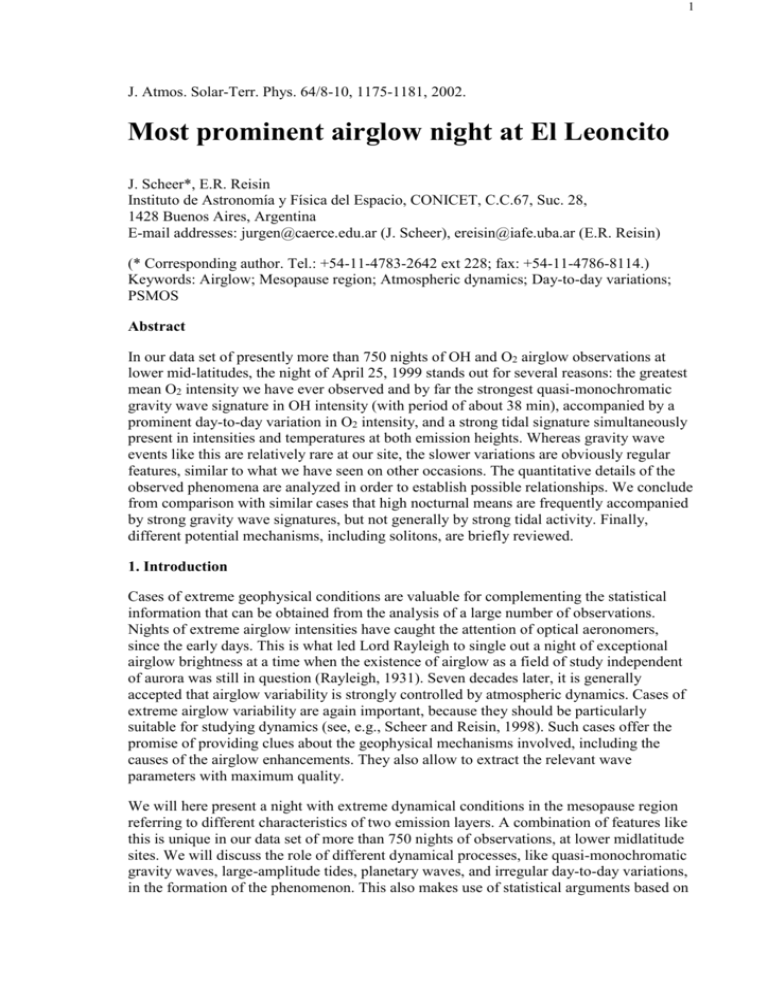
1 J. Atmos. Solar-Terr. Phys. 64/8-10, 1175-1181, 2002. Most prominent airglow night at El Leoncito J. Scheer*, E.R. Reisin Instituto de Astronomía y Física del Espacio, CONICET, C.C.67, Suc. 28, 1428 Buenos Aires, Argentina E-mail addresses: jurgen@caerce.edu.ar (J. Scheer), ereisin@iafe.uba.ar (E.R. Reisin) (* Corresponding author. Tel.: +54-11-4783-2642 ext 228; fax: +54-11-4786-8114.) Keywords: Airglow; Mesopause region; Atmospheric dynamics; Day-to-day variations; PSMOS Abstract In our data set of presently more than 750 nights of OH and O2 airglow observations at lower mid-latitudes, the night of April 25, 1999 stands out for several reasons: the greatest mean O2 intensity we have ever observed and by far the strongest quasi-monochromatic gravity wave signature in OH intensity (with period of about 38 min), accompanied by a prominent day-to-day variation in O2 intensity, and a strong tidal signature simultaneously present in intensities and temperatures at both emission heights. Whereas gravity wave events like this are relatively rare at our site, the slower variations are obviously regular features, similar to what we have seen on other occasions. The quantitative details of the observed phenomena are analyzed in order to establish possible relationships. We conclude from comparison with similar cases that high nocturnal means are frequently accompanied by strong gravity wave signatures, but not generally by strong tidal activity. Finally, different potential mechanisms, including solitons, are briefly reviewed. 1. Introduction Cases of extreme geophysical conditions are valuable for complementing the statistical information that can be obtained from the analysis of a large number of observations. Nights of extreme airglow intensities have caught the attention of optical aeronomers, since the early days. This is what led Lord Rayleigh to single out a night of exceptional airglow brightness at a time when the existence of airglow as a field of study independent of aurora was still in question (Rayleigh, 1931). Seven decades later, it is generally accepted that airglow variability is strongly controlled by atmospheric dynamics. Cases of extreme airglow variability are again important, because they should be particularly suitable for studying dynamics (see, e.g., Scheer and Reisin, 1998). Such cases offer the promise of providing clues about the geophysical mechanisms involved, including the causes of the airglow enhancements. They also allow to extract the relevant wave parameters with maximum quality. We will here present a night with extreme dynamical conditions in the mesopause region referring to different characteristics of two emission layers. A combination of features like this is unique in our data set of more than 750 nights of observations, at lower midlatitude sites. We will discuss the role of different dynamical processes, like quasi-monochromatic gravity waves, large-amplitude tides, planetary waves, and irregular day-to-day variations, in the formation of the phenomenon. This also makes use of statistical arguments based on our other observations. 2. Data and results Our data set consists of a large number (about 240,000) of determinations of rotational temperatures and band intensities for two airglow emissions, OH(6-2) and O2b(0-1), measured in Argentina (El Leoncito, 32º S, and Buenos Aires, 34º S) or Spain (El Arenosillo, 37º N). Most data (more than 600 nights) have been taken since August 1997, from El Leoncito. Details about instrumentation and technique have been given elsewhere (e.g., Scheer 1987, Scheer and Reisin, 2001). 2.1 General characteristics of April 25, 1999 Fig. 1 shows the nocturnal variations of intensities and temperatures of our most prominent airglow night, April 25, 1999. The intensity scales are given in units of the long-term mean (as defined in Scheer and Reisin, 2000), in each emission. Both intensity and temperature for the O2 emission are dominated by a strong tidal modulation, with peak intensities surpassing four times the long-term mean. The simultaneous presence of this tidal signature in the OH emission does not strike the eye, but is nevertheless evident from spectral analysis, as discussed below. A very strong short-period oscillation appears in OH intensity since the beginning of the night, accompanied by less pronounced variations of OH temperature. The final part of this quasi-monochromatic wave event is obliterated by a data gap due to the passage of moonlit clouds. We should mention that a close-by epicenter seismic event of magnitude 4.5 was registered on the site, at 6:10 local time, but without any marked simultaneous signature in our data. This night exhibits the greatest nocturnal mean O2 intensity in all our data set, and the highest O2 temperature measured since 1997. The time history of O2 nocturnal means around April 25, 1999 is shown in the upper panel of Fig. 2. Only three nights are missing in this nearly continuous run of data. There is a clear correlation between mean intensities and temperatures. Before April 25, and except for a minor burst on April 10, intensities remained slightly above average, but somewhat below the typical seasonal level (Scheer and Reisin, 2000). Therefore, the high values of 25 April are reached abruptly. During the following nights, nocturnal means decrease considerably and the previous level is reached three days later. Such a rapid change and short duration are also present in other cases of high intensity bursts in our data set. These bursts look similar to the northern hemisphere spring transition (Shepherd et al., 1999), but tend to be shorter and are not usually accompanied by very low intensities. In general, the day-to-day variation in nocturnal means is believed to be due to planetary waves. The scant variability shown in Fig. 2 suggests only weak planetary wave activity, before the April 25 burst. Nor does the burst itself seem to be related to any planetary wave periodicity. To check for an eventual relation to wave activity at shorter periods, the temporal evolution of the nocturnal means is compared with the variation of tidal amplitudes. The lower panel of Fig. 2 shows the amplitudes of the principal spectral component of the nocturnal variations of O2 temperatures (where the freely fitted periods fell always in the tidal period range). The amplitudes are high for most of the nights (which is similar to our 2 April data in 1998 and 2000), but show no trace of a correlation with the nocturnal means. For April 25, the tidal amplitude is not different from several other high amplitude cases shown in this figure. The only thing special in Fig. 2 might be the low amplitude of the two neighboring nights, although we have no idea whether this is significant. 2.2 Other cases of high nocturnal means To put the April 25 event into context, we now consider the other highest night mean cases, for each of the four parameters. Table 1 shows the monthly distribution of the 36 next-to-principal nights with high mean intensities and/or temperatures in the O2 or OH emission (some of which are prominent in more than one parameter). Most (if not all) of these cases also correspond to abrupt day-to-day variations with short peak duration, similar to April 25, 1999 (many of the intensity bursts are shown in Scheer and Reisin, 2000). The O2 emission events have a very significant preference for April (12 of 20), with the other cases scattered randomly over the other months. Hence, the occurrence of the prominent event in April is not a surprise. The OH emission, from an altitude only about 10 km lower than O2, shows a completely different seasonal distribution, with a clear preference for June and July (12 of 17), and not a single case in April. It should be noted, that in this set of nights there is no prevalence of high tidal amplitudes. There are only six cases with temperature amplitudes greater than 18 K, for at least one emission, while 13 cases have less than 10 K (or no detectable tidal signature), in both emission layers. This means, there is no indication of a correlation between high means and tidal activity, confirming our conclusions drawn from the behaviour during April 1999. About one half of these 36 nights also contain strong quasi-monochromatic gravity wave events (QME), which we define as the occurrence of trains of oscillations, during some part of the night, that are quite pronounced so as to be discernible clearly without spectral analysis. This definition does not necessarily imply unusually strong amplitude. We find that QMEs correspond to relative intensity amplitudes not less than 0.06, which agrees with the (unpublished) mean value for a large statistical ensemble of gravity waves extracted by spectral analysis (Reisin and Scheer, 2001). Hence, there is some overlap with the general, non-monochromatic case, and our practical definition cannot be simply replaced by an amplitude threshold. We see such QMEs in only about 5% of all the nights. That means that the presence of QME in these 36 nights is significantly enhanced by an order of magnitude. This suggests a strong correlation between high nocturnal mean and QME. While not so evident from Table 1, this correlation is not selective about which of the four parameters determines the night mean. With respect to the altitude of the QME, there are three different cases that occur in equal proportion: either, the QME appear in the same airglow layer that corresponds to the high nocturnal mean, or in the other layer, or in both layers. Also, the QME may appear in any part of the night, unrelated to extremes in the nocturnal variation. During some nights, several QME occur at different times. The very enhanced presence of QME in prominent airglow nights suggests a causal relationship with high nocturnal means, but not a simple one. For example, why should a gravity wave in one airglow layer produce, or be generated by, the high mean intensities or 3 temperatures in the other layer? 2.3 Detailed analysis of April 25, 1999 2.3.1 Tidal signatures As mentioned, this night is also a prominent case of tidal signatures identified simultaneously in the four observed parameters, similar to those described by Reisin and Scheer (1996) for our data acquired before 1997. Our new data set now contains about 30 new cases. April 25, 1999 is an excellent example of the semidiurnal tide, where the best fit period is quite close to 12 h (11.5 h; see Table 2), and in good agreement for both emissions. The periods are given in Table 2 (and Tables 3, 4) independently for intensity and temperature oscillations. Their agreement signals the reliable wave identification in each individual emission layer (as done in Reisin and Scheer, 1996). Amplitudes are very high indeed, especially in the O2 emission, so that the tide represents about 90% of the total variance, in intensity and temperature (about 67%, for OH). This is even greater than our previous observations (Scheer and Reisin, 1998). The temperature amplitude in the O2 layer is 1.8 times greater than in the OH layer. This amplitude growth factor exceeds the average of 1.27 0.07 reported earlier (Reisin and Scheer, 1996), but not some of the individual cases given there, and new ones. So, cases of low damping as this are not unusual. For each emission, Table 2 shows Krassovsky's defined as the ratio of relative intensity and temperature amplitudes. The vertical wavelengths obtained from and the phase shift between the intensity and temperature oscillations, via the relation z ( sin)-1 from the Hines and Tarasick (1987) theory are also given in Table 2. A negative sign of and z means downward phase propagation, and vice versa (of course, this distinction becomes irrelevant for close to zero, i.e., very large z). There is a considerable change of vertical wavelengths between emission layers (Table 2). The value for the OH layer coincides with our mean value reported earlier (Reisin and Scheer, 1996), whereas for the O2 layer, it is very large. This difference seems to be real. At any rate, the observed phases at both altitude levels are still consistent with the average vertical wavenumber and the expected layer separation of 5 to 10 km. The O2 temperature amplitude of 20 K is among the half a dozen of highest tidal signatures in this parameter, in our entire data set. From this amplitude, and the mean value 6.7 found empirically for the semidiurnal tide in O2 (Reisin and Scheer, 1996), one should expect also the very high relative intensity amplitude. Therefore, the fact that the absolute intensity amplitude is maximum follows from the very strong tide as well as the extreme nocturnal mean airglow intensity. The opposite conclusion would certainly be wrong: the high nocturnal mean is not just an artifact from a truncated tide, since the data span nearly a complete semidiurnal period, and the low residual variance of the semidiurnal fit suggests no major contribution from the diurnal tide. 2.3.2 Quasi-monochromatic wave The quasi-monochromatic wave signature on April 25 is our best example of a QME that 4 manifests itself in an airglow layer different from the one that exhibits the maximum nocturnal mean. Fig. 3 shows the individual data points for OH intensity during the first part of the night when the strong OH intensity oscillation occurs. Spectral analysis of this part of the data isolates the principal components with periods of 38, 18, 130, and 22 min (see Table 3). The results do not depend significantly on differences in the analysis procedure (like whether or not linear detrending is applied, or whether or not the slow nocturnal variation is subtracted). The first two components describe the essential features of this wave event (as shown by the corresponding reconstruction in Fig. 3, dotted line). Since the period of the second component is (within errors) equal to one-half of the period of the first component, it might be simply its first harmonic. The other two components only add some detail (see fourcomponent reconstruction, solid line). The first component has a relative intensity amplitude of 21% (with respect to mean intensity; see Table 3), while the resulting total variation reaches about 23%. The small values (compatible with 0o) of the first three components suggest that they are probably ducted waves (Hines and Tarasick, 1994) – a point that helps explain the occurrence of large amplitudes (Walterscheid et al., 1999). In this case, the long vertical wavelengths given in the table only indicate the absence of vertical propagation. The values of (see Table 3) are higher than expected, in this period range (i.e. the relative intensity amplitude is far greater than the relative temperature amplitude). In Reisin and Scheer (2001), based on about a thousand gravity wave signatures, less than 3% of the waves have > 8.5 (and < 9%, > 6.4). This suggests that ducted waves may be different from the other gravity waves, also in this respect. For the fourth component, the positive signs of and z signal downward energy propagation and may indicate the presence of wave reflection (Reisin and Scheer, 2001). In the O2 layer, during the presence of the OH layer QME, there are two wave signatures that are too weak to be classified as QME (see Table 4), with periods of 20 and 60 min. The long vertical wavelengths, for these waves, might point to evanescence, rather than ducting, given the relatively small amplitude and the values similar to the average of about two found by Reisin and Scheer (2001), in the general case. It is not easy to decide whether these signatures correspond to the waves seen in the OH layer. Comparison of periods does not supply sufficient clues, because of unknown wind shears that could induce considerable Doppler shifts in the observed periods. It is quite possible that these wave signatures have nothing to do with the QME in the OH layer. At any rate, the evidence suggests that the duct does not include the O2 layer. 3. Discussion and conclusions April 25, 1999 is a prominent case of what seems to be a special class of day-to-day variations. This night has three principal features: - An extreme nocturnal mean in O2 intensity and temperature, with an abrupt day-to-day intensity "burst" by a factor of two, which is not a consequence of tidal extremes. - The strongest (quasi-monochromatic) gravity wave signature in the OH emission layer that we have ever observed, with an intensity modulation of 23%. 5 - A very strong semidiurnal tide with maximum O2 intensity amplitude, which is more weakly but consistently present in the OH layer. The high O2 intensity and the strongly modulated OH intensity indicate that this may be an example of the “bright nights” often described in the past, although, in this case, there were no eye-witnesses to report any spectacular visual display. In other cases of high nocturnal means, we observe a statistically significant association with QME. This lends credibility to the idea that the high means form a class of phenomena that, for some reason, are related to QME conditions. It is important to note that the high nocturnal means often occur at a different height than the monochromatic gravity waves (our prominent night is such a case). In contrast, there is no evidence for a similar correlation with tidal activity. The high tidal amplitudes observed on April 25 seem to be a consequence rather than a determining factor in the generation of the day-to-day burst. One can also exclude a relation to planetary wave activity, which was rather low. The seasonal occurrence of strong day-to-day variations leading to high nocturnal means is strongly concentrated in April for the O2 emission, while for OH this happens in June/July. The April bursts may be related to the northern hemisphere springtime transition (Shepherd et al., 1999), which is the only other detailed documentation of burst-like mesopause day-to-day variations described in the recent literature that we know of. In our results, the difference in the seasonal behaviour between the two emission layers is remarkable. The enhanced presence of quasi-monochromatic gravity wave events during prominent airglow nights suggests that wave ducting conditions may play an important role even for the nocturnal mean airglow bursts. The conditions for gravity wave ducting depend on the vertical temperature and/or wind shear profile, as discussed by Walterscheid et al. (1999). It seems difficult to decide which mechanism might be involved here, especially because of the frequently encountered differences between the heights of the ducts and the burst events. The seismic event at 6:10 LT on April 25 seems to have occurred much too late for causing directly any of the special characteristics of this night. In order to determine which role this event might have played, information about its detailed time history and eventual precursors is required. This information is presently not available. Seismic airglow signatures have been discussed before (e.g. Fishkova et al., 1985), and recently by Mikhalev et al. (2001; see also references therein). Seismic events can somehow supply the wave excitation. However, the issue of wave sources would not affect our present discussion of the observed dynamical situation. Non-dynamical elevations of atomic oxygen concentration are not likely to cause the burst events, since intensity bursts are frequently (if not always) accompanied by a strong (although not always prominent) temperature enhancement. Dynamical explanations of burst events may involve superpositions or interactions of different waves. The diurnal tide and planetary waves (or any other waves in this period range) may eventually combine linearly to create a high-amplitude burst. However, we find it difficult to understand how such a mechanism could show a preference for a certain month, and show no correlation with tidal activity. Non-linear interactions of two (periodic) waves generally produce (also periodic) daughter 6 waves at the sum and difference frequencies of the parent waves. Since the non-linearities are weak in the atmosphere (linear gravity wave theory being a very good approximation), the daughter amplitudes are small, even in cases of constructive interference of different mixing products (Beard and Pancheva, 1999). Because of their large amplitude and the apparent lack of periodicity, burst events probably cannot be explained by this type of interactions. Weak non-linearities can generate the qualitatively different kind of waves called solitons (or solitary waves; e.g., Drazin and Johnson, 1993). Solitons maintain their (generally non-periodic) shape and amplitude even after travelling large distances. In the atmosphere, solitons have been detected at different altitudes, but not with characteristics compatible with the day-to-day bursts. Burst-like solitons (of only about 2 h duration) have been observed in the troposphere (Lin and Goff, 1988). Maybe the first identification of solitons in the mesopause region is the mesospheric bore interpretation that Dewan and Picard (1998) have given to wave features related to a particular “wall event” observed by Taylor et al. (1995) during the ALOHA-93 campaign. Bores are special types of solitons (see Drazin and Johnson, 1993). However, the soliton description is not generally accepted and several alternative interpretations have been proposed for this and other similar wall events (e.g., Swenson et al., 1998). One might even guess that the spring transition events (Shepherd et al., 1999), which involved airglow intensity bursts travelling from Stockholm to Bear Lake (Utah) with little change in shape, could be solitary wave phenomena. These phenomena do have a temporal scale similar to our day-to-day burst events. Perhaps, the properties of the bursts evidenced in the present paper have an explanation in terms of soliton theory. We hope to have shown that even simple zenith observations of airglow can raise many interesting questions about burst-like day-to-day variations. These questions cannot be resolved on the basis of the limited information available, but certainly require a comparison with other observed parameters, involving other sites and satellite observations. The Planetary Scale Mesopause Observing System does supply a suitable environment for progress in this field. At any rate, the different pieces of information presented here may be useful to shed some new light on the “bright night” phenomenology that will help to understand its relation to atmospheric dynamics. Acknowledgements The authors appreciate the continuous support by the staff of Complejo Astronómico El Leoncito that makes the growing set of our measurements possible. This work was partially funded by CONICET PIP 4554/96 and ANPCyT PICT '97-1818 grants. References Beard, A.G., Pancheva, D., 1999. A possible cause for the generation of unusually strong ~20-and 30-hour oscillations in the neutral wind of the lower thermosphere. J. Atmos. Solar-Terr. Phys. 61, 1385-1396. Dewan, E.M., Picard, R.H., 1998. Mesospheric bores. J. Geophys. Res. 103, 6295-6305. Drazin, P.G., Johnson, R.S., 1993. Solitons: an introduction. Cambridge University Press, Cambridge U.K. 7 Fishkova, L. M., Gokhberg, M. B., Pilipenko, V.A., 1985. Relationship between night airglow and seismic activity. Ann. Geophys. 3, 689-694. Hines, C.O., Tarasick, D.W., 1987. On the detection and utilization of gravity waves in airglow studies. Planet. Space Sci. 35, 851-866. Hines, C.O., Tarasick, D.W., 1994. Airglow response to vertically standing gravity waves. Geophys. Res. Lett. 21, 2729-2732. Lin, Y.-L., Goff, R.C., 1988. A study of a mesoscale solitary wave in the atmosphere originating near a region of deep convection. J. Atmos. Sci. 45, 194-205. Mikhalev, A. V., Popov, M. S., Kazimirovsky, E. S., 2001. The manifestation of seismic activity in 557.7 nm emission variations of the Earth's upper atmosphere. Adv. Space Res. 27 (6-7), 1105-1108. Rayleigh, (R.J. Strutt, 4th Lord R.), 1931. On a night sky of exceptional brightness, and on the distinction between the polar aurora and the night sky. Proc. Roy. Soc. (London) A131, 376-381. Reisin, E.R., Scheer, J., 1996. Characteristics of atmospheric waves in O2(0-1) Atmospheric and OH(6-2) airglow at lower midlatitudes. J. Geophys. Res. 101, 21,223-21,232. Reisin, E.R., Scheer, J., 2001. Vertical propagation of gravity waves determined from zenith observations of airglow. Adv. Space Res 27 (10), 1743-1748. Scheer, J., 1987. Programmable tilting filter spectrometer for studying gravity waves in the upper atmosphere. Appl. Opt. 26, 3077-3082. Scheer, J., Reisin, E.R., 1998. Extreme intensity variations of O2b airglow induced by tidal oscillations. Adv. Space Res. 21 (6), 827-830. Scheer, J., Reisin, E.R., 2000. Unusually low airglow intensities in the Southern Hemisphere midlatitude mesopause region. Earth Planets Space. 52, 261-266. Scheer, J., Reisin, E.R., 2001. Refinements of a classical technique of airglow spectroscopy. Adv. Space Res. 27 (6-7), 1153-1158. Shepherd, G.G., Stegman, J., Espy, P., McLandress, C., Thuillier, G., Wiens, R.H., 1999. Springtime transition in lower thermospheric atomic oxygen. J. Geophys. Res. 104, 213-223. Swenson, G.R., Qian, J., Plane, J.M.C., Espy, P.J., Taylor, M.J.,Turnbull, D.N., Lowe, R.P., 1998. Dynamical and chemical aspects of the mesospheric Na "wall"event on October 9, 1993 during the Airborne Lidar and Observations of Hawaiian Airglow (ALOHA) campaign. J. Geophys. Res. 103, 6361-6380. Taylor, M.J., Turnbull, D.N., Lowe, R.P. , 1995. Spectrometric and imaging measurements of a spectacular gravity wave event observed during the ALOHA-93 campaign. Geophys. Res. Lett. 22, 2849-2852. Walterscheid, R.L., Hecht, J.H., Vincent, R.A., Reid, I.M., Woithe, J., Hickey, M.P., 1999. Analysis and interpretation of airglow and radar observations of quasi-monochromatic 8 gravity waves in the upper mesosphere and lower thermosphere over Adelaide, Australia (35°S, 138°E). J. Atmos. Solar-Terr. Phys. 61, 461-478. FIGURE CAPTIONS Fig. 1: Nocturnal variations of airglow O2b(0-1) and OH(6-2) band intensities and temperatures at El Leoncito, April 25, 1999. Intensities are normalized with respect to long-term averages. (Systematic difference in O2 and OH temperature levels is not necessarily real). Fig. 2: Upper panel: nocturnal mean O2 band intensities (open circles, dashed lines) and temperatures (dots, solid lines) at El Leoncito in April 1999. Lower panel: corresponding amplitude of nocturnal O2 temperature variation in tidal period range. Lines connect only consecutive nights. Arrows point to prominent airglow night, April 25. Fig. 3: OH intensity variation during the first part of the prominent night (circles). Reconstructions of oscillations using two (dotted line) and four (solid line) main spectral components (see Table 3). Intensity scale is not normalized, here. TABLES Table 1: Number of prominent nocturnal means, per month, 1997 - 2000, for O2, OH intensity and temperature. Also, cumulative number of nights prominent in any parameter, and the number of these that contain monochromatic gravity wave signatures. Month Jan Feb Mar Apr May Jun Jul Aug Sep Oct Nov Dec Total IO2 1 7 TO2 IOH 1 1 2 7 2 1 1 1 9 13 TOH 1 6 3 1 3 2 1 10 1 10 Any 0 1 4 12 1 7 7 0 1 2 0 1 36 With GW 1 1 5 0 4 6 0 0 0 17 Table 2: April 25, 1999 tidal characteristics in both emissions. Periods are obtained independently for the intensity and temperature fluctuations. Intensity amplitudes are given in the same relative units as in Fig. 3, and also as percentage of mean intensity. Krassovsky's is derived from the amplitude ratios, from phase difference, of intensity and temperature oscillations. Vertical wavelength z is derived from and . lay er O2 OH Intensity Temperat. period[s] period[s] 41670 40834 38842 43296 Intensity Temp. ampl.(rel) ampl.[K] 6745 (58%) 19.7 1786 (27%) 11.1 [o] z [km] 6.6 4.7 -9 -80 -140 -27.3 9 Table 3: April 25, 1999 gravity wave characteristics from the OH emission. Same notation as Table 2. Intensity period[s] 2246 1090 7778 1322 Temperat. period[s] 2272 1090 10462 1314 Intensity Temp. ampl.(rel) ampl.[K] 1615 (21%) 4.4 607 (8%) 2.1 616 (8%) 2.2 496 (6%) 2.8 [o] z [km] 8.6 6.6 6.5 4.2 -1 -3 -8 47 -700 -390 -130 39.8 [o] z [km] 2.8 1.9 14 -24 200 -170 Table 4: Same as Table 3, but for the O2 emission. Intensity period[s] 1220 3314 Temperat. period[s] 1195 3842 Intensity Temp. ampl.(rel) ampl.[K] 216 (4%) 2.9 127 (2%) 2.6 10 Fig. 1: Nocturnal variations of airglow O2b(0-1) and OH(6-2) band intensities and temperatures at El Leoncito, April 25, 1999. Intensities are normalized with respect to long-term averages. (Systematic difference in O2 and OH temperature levels is not necessarily real). 11 Fig. 2: Upper panel: nocturnal mean O2 band intensities (open circles, dashed lines) and temperatures (dots, solid lines) at El Leoncito in April 1999. Lower panel: corresponding amplitude of nocturnal O2 temperature variation in tidal period range. Lines connect only consecutive nights. Arrows point to prominent airglow night, April 25. 12 Fig. 3: OH intensity variation during first part of the prominent night (circles). Reconstructions of oscillations using two (dotted line) and four (solid line) main spectral components (see Table 3). Intensity scale is not normalized, here. 13
